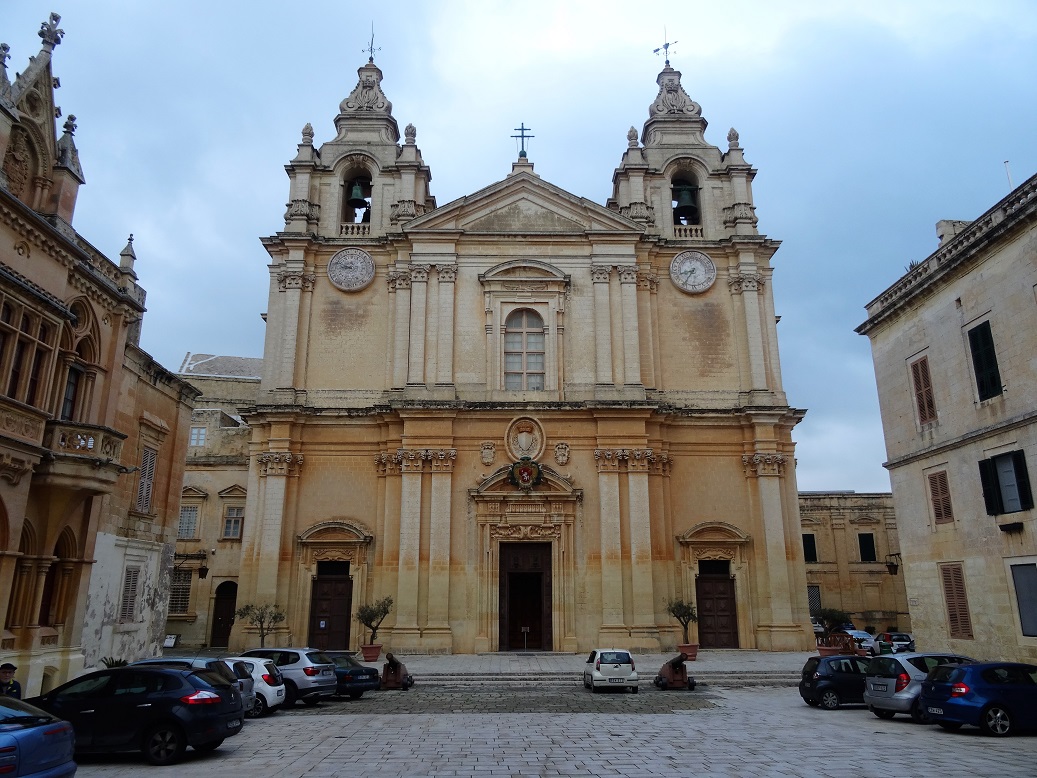


|
|
|
|||||||||||||||
|
|
||||||||||||||||
|
|
|||
|
|
Mdina
St Paul's Cathedral 
Located amongst the medieval streets in the heart of Mdina, seven miles from Valletta, St. Paul's Cathedral, or the Mdina Cathedral, is dedicated to Saint Paul, the patron saint of Malta. Tradition states that the cathedral was built on the site where the Roman governor Publius met St. Paul following the latter’s shipwreck on Malta in 60 AD. The present cathedral can be traced back to the 12th century, when a Norman church stood on the site, although a church dedicated to the Virgin Mary existed here even earlier, prior to the Arab invasion of 870 AD. This first church suffered considerable damage during the Arab occupation. After the expulsion of the Arabs by the Normans in 1091, Christianity once again became the dominant religion on the island. A new church was built on the site during the 12th and 13th centuries which was dedicated to St. Paul. This church was built in the Gothic and Romanesque styles. Over the years it underwent a number of modifications and enlargements. In 1693 it suffered extensive damage in an earthquake which resulted in its demolition and the current cathedral being built. Work on the new cathedral began in 1696 and most of it was completed by 1702, when it was consecrated by the Bishop of Malta on 8 October of that year. It is in the Baroque style and was designed by Lorenzo Gafa. The cathedral was fully completed on 24 October 1705. The new building incorporated many of the artefacts that had survived the earthquake that damaged the previous building. In 1856, the current cathedral was damaged in yet another earthquake, which destroyed the 18th-century frescoes on the dome. Today, the cathedral is a Grade 1 national monument and one of the main tourist attractions of Mdina. It is the seat of the Roman Catholic Archdiocese of Malta, a function it has shared since the 19th century with St. John's Co-Cathedral in Valletta. The cathedral’s facade looks out on St Paul’s Square, which is surrounded by buildings faced with marble and ornate masonry. This square was created in the late 1720s with the demolition of medieval houses to the south of the cathedral. The square was enlarged in the early 19th century following the demolition of more medieval buildings to make room for the Bishop's Palace and the Seminary, which in 1969 became the Cathedral Museum. Divided into three bays by pilasters of Corinthian and Composite orders, the cathedral rises on three steps from the Square. The central bay, which contains the main door to the nave, is set forward from the other two which are bell towers. Above the doorway of the central part are the coats of arms of the city of Mdina, Grand Master Ramon Perellos y Roccaful, who was the Grand Master of the Order of Malta during the rebuilding of the cathedral, and Bishop Davide Cocco Palmieri, the Bishop of Malta between 1684-1711. The coloured coat of arms of the current archbishop is located just below the coat of arms of Mdina. The façade contains a triangular pediment and the building is topped by a red-and-white striped dome. The interior of the cathedral is set out in the plan of a Latin Cross. This is a cross like the one on which Jesus was crucified with a long descending arm. The interior has a vaulted nave with two aisles and the ceiling contains frescoes depicting the life of St. Paul. Over the years the ceiling paintings have been replaced several times due to damage, the last time being in the 1920’s, although additional restoration work was carried out in 1956. The interior has a rich appearance with vibrant colours and contains many beautiful paintings and artefacts. The baptismal font is late Gothic/early Renaissance and is dedicated to the conversion of St. Paul. It was salvaged from the pre-1693 cathedral and dates to 1495. Also used from the pre-1693 cathedral was the main door dating from 1530, made of carved Irish bog wood, which now leads to the vestry. Most of the marble-inlaid floor is covered with tombstones and commemorative inlaid marble slabs. The tombs are those of several bishops and nobles. Some of the marble used to decorate the cathedral comes from the Roman ruins of Melite (Maleth) and from Carthage. Between the apse and main altar is a monumental depiction of the conversion of St. Paul, painted by Mattia Preti, which came from the original church. Also surviving from the old church are the 15th-century Tuscan panel painting of the Madonna and Child and the frescoes in the apse depicting St. Paul’s shipwreck on Malta. To see more photographs and take a virtual tour of the site click on the photoshow below. |
|
|
|
|
|||
All Photographs were taken by and are copyright of Ron Gatepain
| Site Map |
